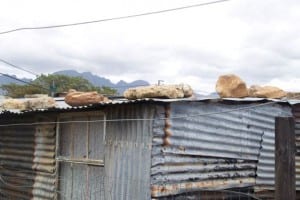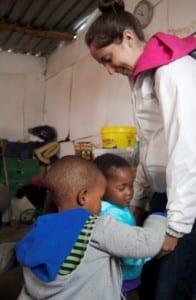Scene 1: Nobathembu’s Crèche
Back-story:
After connecting with our liaison and learning about Kiddies College Preschool, it was time to move our project to the next level. We brought our liaison, Ms. May, with us to the informal settlement of Langrug. There we began to explore and learn about the local crèches.
Cast of characters:
Ms May
ECD Team
Nobathembu- Leader of a crèche in Langrug
Setting:
A cool gust of wind kissed my face as we stepped out the car. It was a dreary day, clouds over taking the sky. As I put my foot down for the first time in Langrug my shoe sank into the mud, leaving clear footprints behind me. I gazed around at the area. Electrical wires hung just inches over my head, connecting to some of the few fortunate houses that had electricity. The roofs were made of aluminum, rusted and held down by rocks so they would not blow off in the wind. Under these roofs were patches of rusted metal , walls only about seven feet high and insulated with old newspaper. Most of the shacks had one door and a window. These shacks are what many people called home. The ground was all dirt, littered with bottle caps and other debris. On the side of the road, there was a canal with a steady stream of murky water running through it, only to be disrupted by empty bags of crisps or other rubbish. In the distance, I could hear the sounds of a herd of goats. They were soon spotted sticking their heads into an over flowing trash bin. The community leader, Alfred, introduced himself to us; he would be our translator and tour guide for the day. He quickly showed us the handshake of Langrug, that way we knew how to greet the locals. He began our tour by showing us the first crèche.
As we entered the church shack, particles of dust glittered in the air as a single stream of light cast through the window, providing the only light in the dim shack. I slowly observed the room and about 60 small children in it. The tin walls buckled back and forth whenever a child leaned on them. The smell of propane had filled the air from a portable stovetop. This shack was warmer than the other shacks we saw as the stove was boiling water for lunch. A series of different colored carpets made up the floor. Small benches lined the parameter of the walls. In the back of the room there were four small, different colored, plastic tables with matching plastic chairs each filled by a child. To my right, children were sitting on the carpet cross-legged, paying close attention to the one teacher sitting in a chair. As I turned around I saw a young girl raising her pants. She had just finished urinating in a Tupperware container. She grabbed the container by the handle and proceeded to bring it outside. We then greeted Nobathembu, the head teacher for the first time.
Scene:
Connecting:
We were able to introduce Ms. May to Nobathembu, the owner of this crèche, in hopes that we will be able to have a teacher workshop so that both parties can share their skills. Our group was also able to talk with Nobathembu to begin to foster a relationship with our group and the CTPC.
Planning:
Since this was our group’s first time visiting an informal settlement, we didn’t truly know what to expect of Langrug. We spoke with Scott, Lorraine and the WaSH team about their experiences and what we should plan for, but it was left up to our imaginations to picture what was there and what we would experience ourselves. Lorraine had shown us a picture of Nobathembu’s crèche with the nearly 60 children coinciding there, so we had a small idea of what to expect at the crèche.
Once it was finalized when we would visit Langrug, we called Neville, our local bus driver. The only official plan we had was meeting Ms. May in Observatory at 9:15 AM then driving out to Langrug to meet with Nobathembu and getting a tour of the settlement.
Action and Observation:
As Alfred led us up the dirt paths and between the destitute shacks toward the one which was the church that Nobathembu’s crèche resided in, we had a vague idea of what to anticipate. Alfred came to a stop and said, “This is it.” I looked up at the church and saw slabs of wood put together as the siding with a roof made from scraps of riveted metal. Alfred then led us through the door. Nobathembu greeted us there with the rest of the children and teachers behind her in a circle all staring up at us. We said our hellos and gave them the paper and dolls that Ms. May and Julie brought as a gift to thank Nobathembu for welcoming us. Nobathembu’s face lit up as she received the gifts, thanking us numerous times for out generosity.
We were then swarmed by children coming to hug us and high five us. The children were enthused to meet us and to have the chance to hold our hands. One of the children tried to speak to me in Xhosa while I tried to answer in English. This was the first time I have been exposed to a language barrier between myself and children here in Cape Town. Somehow, we were all able to speak to each other through our gestures, like high fives and hugs. This showed the children my compassion and enthusiasm to be with them.
Once the swarm of children retreated from us back to their circle or tables, Nobathembu brought out her Non-Profit Organization (NPO) registration certificate, showing that the government recognized the crèche as an organization but not necessarily an ECD centre. This crèche and the others we had seen that day are nowhere close to meeting the government regulations for registration as an ECD centre, simply due to the lack of space and number or learners per teacher. Ms. May spoke with Nobathembu for a few quick moments and wrote down her cell phone information before we had to leave. As we were taking the few jagged steps out of the crèche, I looked back at the single room filled with all those children and waved goodbye.
Fast-forwarding a few hours, Julie and I frantically ran up the main dirt path to catch Nobathembu as she was walking from the WaSH facility back to her crèche. We had forgotten to give her the bag of freshly cut oranges to feed the children when we first visited. Julie and I walked with her back to the crèche, carrying the bag for her. On this walk she talked about herself and her crèche. She told us she started this crèche by herself one year ago at the calling of God. She told us that she left her life behind and followed this calling to work in Langrug and teach out of the greatness of her heart.
Reflection and Learning:
Reflecting back on this experience is both insightful and inspiring. My experiences in Langrug have made me realize how much I have taken for granted – the 3 bathrooms in my home, my healthy family sitting around the dinner table full of food every night, the education I have received, the warm and comfy beds my family sleeps in, the iPhone always in my back pocket, the MacBook Pro laptop I am currently typing on, and all of the other luxuries I have been lucky enough to have had throughout my life. The people of this settlement and all of the other informal settlements throughout this country do not always have these luxuries, or even all of the necessities to lead a healthy life. They often do not receive the ECD that should be provided to all. They dwell in a single room full of 60 other children and 2 teachers during the day while their families are. If they are not in a crèche, often they are wandering the streets aimlessly. It is hard and scary to think of where I would be today if I were walking in the shoes of these people.
Also, I am struck by the compassion and love Nobathembu has for this crèche and the 60 children she cares for. She selflessly dropped everything she had and started this centre. The families of children who attend only pay R100 a month if they can even afford that at all. She does this all out of the goodness of her heart and her faith in God. Although not everyone has faith in God or any gods for that matter, Nobathembu’s story still exemplifies the greatness of people in the world. She and other people like her are what keep settlements like Langrug in positive spirits. Even though some South African’s live in the most destitute of places, some can still lead happy lives. It truly is the people that make up the settlement, not the infrastructure. I am inspired to become even half the woman that Nobathembu is.





